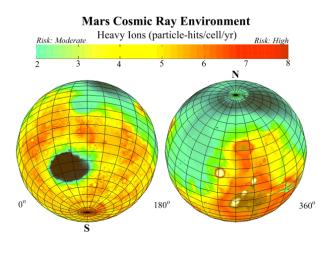Estimated Radiation on Mars, Hits per Cell Nucleus
Caption:
This global map of Mars shows estimates for amounts of high-energy-particle cosmic radiation reaching the surface, a serious health concern for any future human exploration of the planet.
The estimates are based on cosmic-radiation measurements made on the way to Mars by the Mars radiation environment experiment, an instrument on NASA's 2001 Mars Odyssey spacecraft, plus information about Mars' surface elevations from the laser altimeter instrument on NASA's Mars Global Surveyor. The areas of Mars expected to have least radiation are where elevation is lowest, because those areas have more atmosphere above them to block out some of the radiation. Earth's thick atmosphere shields us from most cosmic radiation, but Mars has a much thinner atmosphere than Earth does.
Colors in the map refer to the estimated average number of times per year each cell nucleus in a human there would be hit by a high-energy cosmic ray particle. The range is generally from two hits (color-coded green), a moderate risk level, to eight hits (coded red), a high risk level.
Background Info:
NASA's Jet Propulsion Laboratory, Pasadena, Calif. manages the 2001 Mars Odyssey and Mars Global Surveyor missions for NASA's Office of Space Science, Washington D.C. The Mars radiation environment experiment was developed by NASA's Johnson Space Center. Lockheed Martin Astronautics, Denver, is the prime contractor for Odyssey, and developed and built the orbiter. Mission operations are conducted jointly from Lockheed Martin and from JPL, a division of the California Institute of Technology in Pasadena.
Cataloging Keywords:
| Name |
Value |
Additional Values |
| Target |
Mars |
|
| System |
|
|
| Target Type |
Planet |
|
| Mission |
2001 Mars Odyssey |
Mars Global Surveyor (MGS) |
| Instrument Host |
Mars Odyssey |
Mars Global Surveyor |
| Host Type |
Orbiter |
|
| Instrument |
Mars Radiation Environment Experiment (MARIE) |
|
| Detector |
|
|
| Extra Keywords |
Atmosphere, Color, Map |
| Acquisition Date |
|
| Release Date |
2002-03-01 |
| Date in Caption |
|
|
| Image Credit |
NASA/Jet Propulsion Laboratory/JSC |
| Source |
photojournal.jpl.nasa.gov/catalog/PIA03479 |
| Identifier |
PIA03479 |

 Planetary Data System
Planetary Data System
